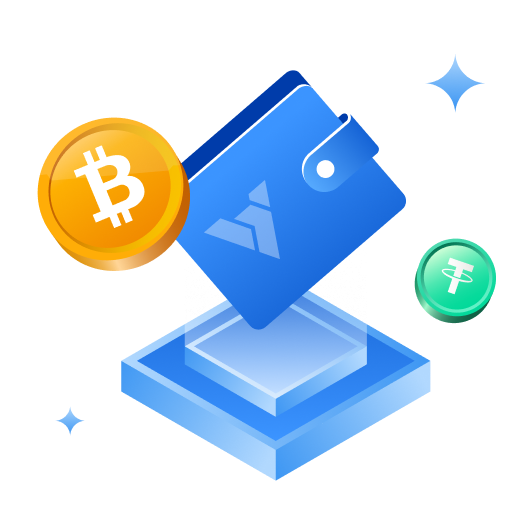*五个步骤即可于 BYDFi 购买
*免费开立 BYDFi 账户
*使用您的邮箱/手机号码和居住国家/地区注册 BYDFi,并创建一个強密码來保护您的账户
*保护您的账户安全
*请启用谷歌身份验证(2FA),设置防钓鱼码,交易密码,为您的账户多加一层保护
*验证账户
*您可通过输入个人信息和上载有效身份证的照片来*验证您的个人身份
*添加付款方式
*你的 BYDFi 帐户验证后,请新增信用卡/借记卡或银行帐户
Buy
*可选用多种付款方式于 BYDFi 购买EBOX。我们将引导你进行操作
*选择于 BYDFi 购买 EBOX 的方式
*于BYDFi购买加密货币非常简单方便。来探索如何以不同方式购买
- 1
*使用信用卡或借记卡购买
*这是新用户最简单购买(EBOX)的方式。 将您的信用卡或借记卡连接到您的账户,输入购买金额,然后等待交易完成
- 2
*透过第三方渠道购买
*BYDFi 支持各种领先的第三方支付处理器。 访问我们的*第三方支付頁面*查看您所在地区可用的支付方法
- 3
*在 BYDFi 现货市场用加密货币购买
*BYDFi 现货市场支援 700 多种数码资产,是购买最受欢迎的平台。购买方法如下:*1. 通过 BYDFi 的快捷买币通道、P2P 及第三方买家购买稳定币。或者,您也可将其他钱包或交易平台的加密资产转移到 BYDFi 平台。请确保选择正确的区块链网络,一旦将加密资产储存到错误地址将无法逆转*2. 将你的加密货币转到 BYDFi 交易帐户。 在 BYDFi 现货市场寻找希望交易的的交易对。下单将你现有的加密货币兑换为*提示:BYDFi 提供多种订单类型在现货市场购买,例如即时购买的市场订单和以指定价格购买加密货币的限价订单。 有关 BYDFi 订单类型的更多信息,请点击此处
*3. 订单一旦执行成功,即可在交易帐户中查看可用的
*如何存储
*储存 的最佳方式因您的需要和偏好而异。 查看优缺点以找到储存 的最佳方法
*将EBOX存储在你的 BYDFi 账户中
*在您的 BYDFi 账户中持有您的加密货币可以快速访问交易产品,例如现货和合约交易、质押、借贷等。 BYDFi 作为您加密资产的托管人,帮助您免去自行保管私钥的麻烦。 确保设置强密码并升级您的安全设置,以防止恶意行为者获取您的资金
*将你的EBOX存放在非托管钱包
*「无匙即无币,币匙为一体」如果安全是您最关心的问题,您可以将您的 提取到非托管钱包。 将 储存在非托管或自托管钱包中可让您完全控制您的私钥。 您可以使用任何类型的钱包,包括硬件钱包、Web3钱包或纸质钱包。 请注意,如果您希望频繁交易您的 或使用您的资产,此选项可能不太方便。 请务必将您的私钥储存在安全位置,因为丢失它们可能会导致您的 永久丢失
*你于 BYDFi 可以如何使用
*持有
*在你的BYDFi帐户中储存。
Trade
*在现货市场和期货市场中交易。

*为何 BYDFi 是购买 的最佳平台?
*安全可靠
*我们的常规储备证明 (PoR) 机制确保客户资金得到 1:1 实物资产的支持。 BYDFi 被福布斯评2021 年最佳加密货币交易所之一,并被 Ascent评为 2022 年最佳加密货币应用程式
*高流动性
*BYDFi 针对所有已上市的加密货币拥有高流动性的买卖订单,可提供点差较小的流动性交易体验
*加密货币 Gem 之家
*BYDFi 支援 700 多种加密货币,是寻找下一个加密货币 Gem 的最佳平台。于 BYDFi 可购买到EBOX以及使用其兑换各种数码资产
*介面简便
*由于我们的介面简便、技术强劲,于 BYDFi 购买快捷方便。于 BYDFi 买币即可获得EBOX
Trade
*问答
 What Is ebox ($EBOX)?
What Is ebox ($EBOX)?
Safe sending:
ebox provides a unique solution to a problem in cryptocurrency trading that is as devastating as it is widespread. Accidentally sending funds to a mistyped or mistaken recipient address has already been the cause for hundreds of millions, if not billions, of financial damage. Harnessing the cryptographically unbreakable safety of the underlying Ethereum blockchain, ebox provides a smart contract based digital escrow service to completely alleviate any risk of loss while sending cryptocurrency
Privacy:
Sending funds through ebox disrupts the chain of transparently trackable blockchain transactions, thereby obfuscating their origin and destination. For situations where discretion is required, users have the option of wrapping ebox transactions with an additional layer of privacy, for a small increase in service fee. When using this added privacy feature, both sender and recipient addresses are encrypted locally on users computers. No clear-text addresses are ever transmitted into the internet or stored on-chain, and users may remain anonymous to each other. Any attempt to reconstruct added-privacy transactions between ebox users becomes tremendous effort, if not impossible.
OTC
On top of securing transaction, ebox offers an easy and convenient way of trading Ether and ERC-20 tokens. Funds can be sent & requested a single transaction, which may only be fulfilled once both the sending and receiving party have put in their part. This gives users a safe, reliable environment for OTC trading that is immune to any form of fraud or scam. Safeguarded by the ebox smart contract, ebox OTC transactions are guaranteed to take place in the only way that is acceptable, being fair and mutually beneficial for both parties
 What makes ebox unique?
What makes ebox unique?
Users can either deposit funds inside the ebox smart contract (send), or retrieve funds that have previously been deposited by another user (receive).In order to guarantee that only the designated recipient of a transaction is able to receive the funds, the ebox smart contract takes the recipients address (authenticated through MetaMask) as one part of a two-factor authentication.
The other part is a passphrase, that is arbitrarily chosen by the sender of a transaction.
This means that for retrieving funds, the recipient has to be connected to ebox through MetaMask using the address that was specified by the sender as recipient, and know the correct passphrase.
For all of this to work, the ebox smart contract has to keep track of what is going on – Who deposited how much, for whom, with what passphrase?
The passphrase part is critical about this, as it cant be stored in the smart contract in clear-text for obvious reasons, given that any data on any smart contract can be viewed by anyone at any time.
Therefore, the ebox smart contract stores merely the Keccak-256 / SHA-3 hash value of each transactions correct passphrase.
Hashing is one of the basic underlying concepts of blockchain technology in general, which implies that the safety and reliability of ebox goes hand in hand with the blockchain itself, making it just as unbreakable.
Mode of operation Applying this knowledge to how ebox stores transaction passphrases, this means that ebox can validate any passphrase that it is told by a user trying to retrieve funds, without actually knowing what the passphrase is.
In order to retrieve funds, users are required to enter a passphrase, which is then submitted to the ebox smart contract.The smart contract then computes the hash of that submitted passphrase, and compares it to what it has stored inside its memory, which is the hash of the correct passphrase (but not the actual correct passphrase itself).
 Who Are the Founders of ebox?
Who Are the Founders of ebox?
ebox was founded by Lukas Schiefer, Lukas Pratschner, and Paul Simode, who knew each other for more than 15 years before starting the project. Together, they bring decades of experience and activity in the crypto space as well as knowledge in different areas.
Lukas Schiefer studied renewable energy at University of Applied Sciences in Vienna and has been a community manager in crypto for several platforms, as well as a long-term evangelist of the industry.
Lukas Pratschner is an experienced cryptocurrency angel investor and researcher who has been active in the community for a big part of its history. He has worked in different areas like chemical process engineering and laboratory technology, as well as in certification, auditing, and inspection.
Lastly, Paul Simode has been interested in technology since he was a kid, using C/C++ and Assembly languages in his incursions in cybersecurity. He is a software developer who is in charge of the technical aspects of Ebox.

